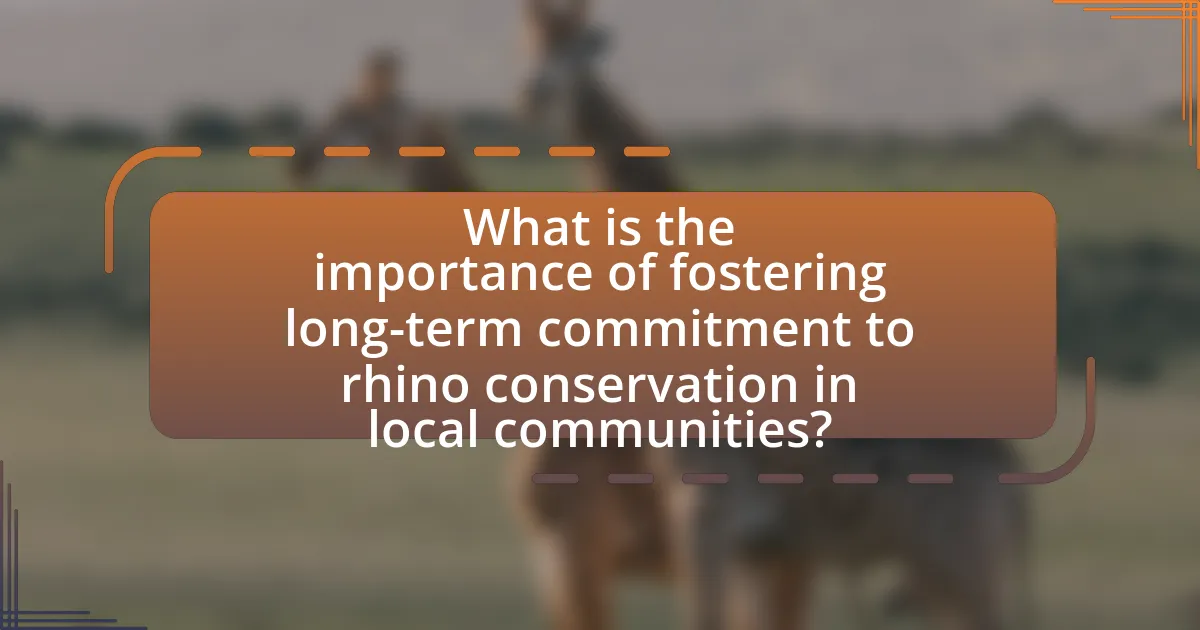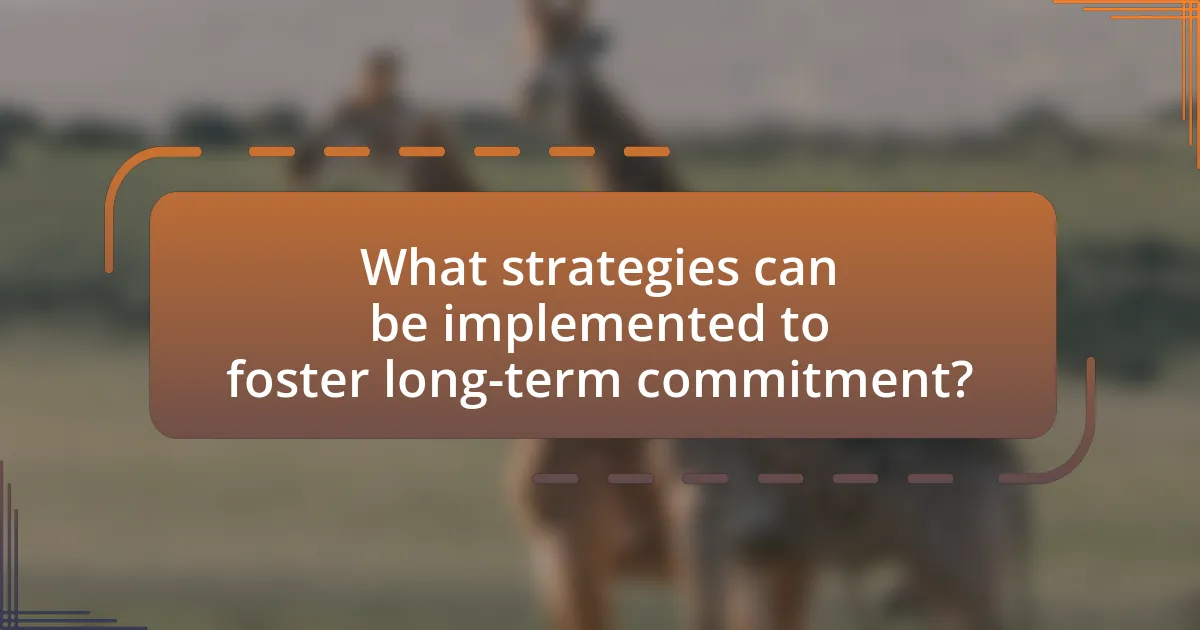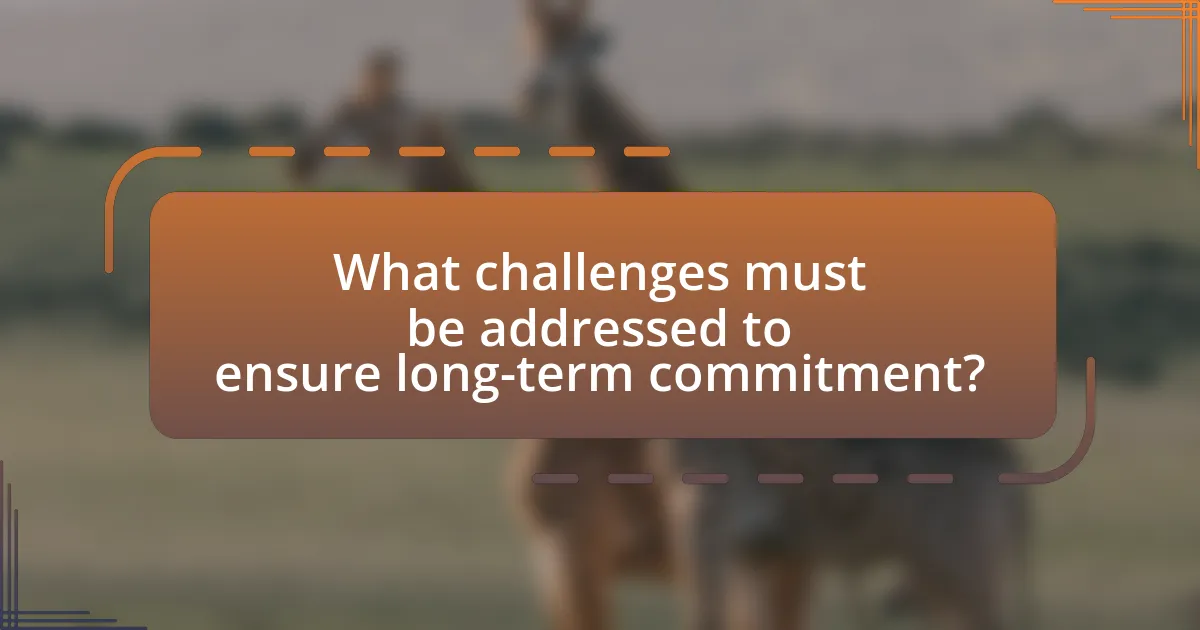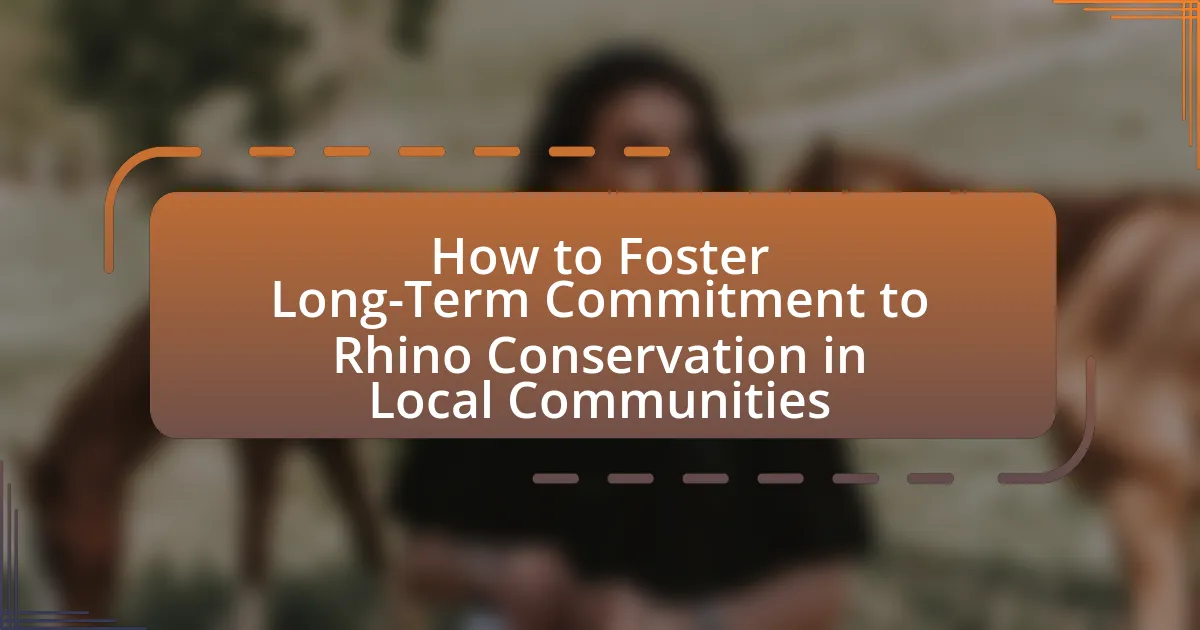The article focuses on the importance of fostering long-term commitment to rhino conservation within local communities. It highlights how community involvement enhances conservation efforts by promoting local stewardship, reducing poaching, and aligning economic benefits with conservation goals. Key factors motivating community engagement include economic incentives, social cohesion, and cultural values. The article also discusses the role of education, awareness programs, and stakeholder collaboration in strengthening community commitment to rhino protection, while addressing challenges such as resource limitations and distrust in authorities. Overall, it emphasizes that sustained commitment is essential for the successful conservation of rhinos and the well-being of local communities.

What is the importance of fostering long-term commitment to rhino conservation in local communities?
Fostering long-term commitment to rhino conservation in local communities is crucial for ensuring sustainable protection of rhino populations. This commitment leads to increased local stewardship, where communities actively participate in conservation efforts, reducing poaching and habitat destruction. Studies indicate that when local communities are engaged and benefit economically from conservation, such as through eco-tourism, they are more likely to protect rhinos. For instance, a report by the World Wildlife Fund highlights that community-based conservation initiatives in Namibia have resulted in a significant increase in rhino populations, demonstrating the effectiveness of local involvement in conservation strategies.
How does community involvement impact rhino conservation efforts?
Community involvement significantly enhances rhino conservation efforts by fostering local stewardship and increasing awareness of the species’ plight. When communities actively participate in conservation initiatives, they develop a vested interest in protecting rhinos, which can lead to reduced poaching and habitat destruction. For instance, a study published in the journal “Conservation Biology” found that community-based conservation programs in South Africa resulted in a 50% decrease in rhino poaching incidents over five years, demonstrating the effectiveness of local engagement. Additionally, involving communities in decision-making processes ensures that conservation strategies align with local needs and values, further strengthening commitment to rhino protection.
What are the key factors that motivate communities to engage in conservation?
Communities are motivated to engage in conservation primarily by economic benefits, social cohesion, and cultural values. Economic benefits arise from sustainable practices that provide livelihoods, such as eco-tourism and sustainable agriculture, which can enhance community income while preserving natural resources. Social cohesion is fostered through collective action and shared goals, leading to stronger community bonds and a sense of ownership over local ecosystems. Cultural values play a significant role, as many communities have deep-rooted traditions and beliefs that emphasize the importance of nature and wildlife, motivating them to protect their environment. These factors collectively drive community involvement in conservation efforts, ensuring both ecological sustainability and socio-economic development.
How does local culture influence conservation practices?
Local culture significantly influences conservation practices by shaping community values, beliefs, and behaviors towards wildlife and natural resources. For instance, in regions where local traditions emphasize the spiritual significance of rhinos, communities are more likely to engage in protective measures and sustainable practices that benefit these animals. Research conducted by the World Wildlife Fund highlights that indigenous knowledge and cultural heritage can enhance conservation efforts, as local communities often possess valuable insights into ecosystem management and species protection. This cultural connection fosters a sense of stewardship, leading to increased participation in conservation initiatives and a commitment to preserving biodiversity.
Why is long-term commitment essential for successful conservation?
Long-term commitment is essential for successful conservation because it ensures sustained efforts and resources are allocated to protect ecosystems and species over time. Conservation initiatives often require years, if not decades, to yield measurable results, such as population recovery or habitat restoration. For instance, the recovery of the black rhino population in Kenya, which increased from approximately 2,400 individuals in 1995 to over 5,000 in 2021, demonstrates that consistent conservation efforts, including anti-poaching measures and habitat management, are crucial for achieving long-term success. Without a long-term commitment, conservation projects risk losing momentum, funding, and community support, ultimately jeopardizing the survival of endangered species and the health of their habitats.
What are the consequences of short-term conservation efforts?
Short-term conservation efforts can lead to temporary improvements in wildlife populations and habitats but often fail to create lasting change. These initiatives may result in immediate benefits, such as increased animal sightings or reduced poaching incidents, but without sustained commitment and resources, these gains are typically short-lived. For example, a study published in the journal “Conservation Biology” found that while short-term anti-poaching patrols can reduce illegal hunting, the effects diminish once the patrols cease, highlighting the need for ongoing support and community involvement to ensure long-term success in conservation efforts.
How does sustained commitment benefit both rhinos and local communities?
Sustained commitment benefits both rhinos and local communities by ensuring effective conservation efforts that protect rhino populations while simultaneously enhancing local livelihoods. For instance, consistent funding and support for anti-poaching initiatives lead to a decrease in rhino poaching rates, which has been shown to stabilize and increase rhino populations in regions like South Africa, where the population rose from approximately 18,000 in 2012 to over 18,500 in 2021. Additionally, local communities gain from eco-tourism opportunities generated by healthy rhino populations, providing jobs and income, as evidenced by studies indicating that eco-tourism can contribute up to 10% of GDP in some African nations. This symbiotic relationship fosters a sense of ownership and responsibility among local communities, further reinforcing their commitment to conservation efforts.

What strategies can be implemented to foster long-term commitment?
To foster long-term commitment to rhino conservation in local communities, strategies such as community engagement, education, and economic incentives can be implemented. Community engagement involves involving local populations in conservation efforts, which increases their investment in the outcomes. Education programs that inform communities about the ecological and economic benefits of rhinos can enhance awareness and support for conservation initiatives. Economic incentives, such as eco-tourism opportunities or compensation for wildlife-related losses, provide tangible benefits that encourage communities to protect rhinos. Research shows that communities actively involved in conservation efforts are more likely to sustain those efforts over time, as evidenced by successful programs in South Africa where local participation has led to increased rhino populations.
How can education and awareness programs enhance community engagement?
Education and awareness programs enhance community engagement by providing knowledge and fostering a sense of responsibility towards local conservation efforts. These programs equip community members with information about the ecological importance of rhinos and the threats they face, which can lead to increased participation in conservation activities. For instance, studies have shown that communities involved in educational initiatives are more likely to support conservation policies and practices, as evidenced by a 2019 report from the World Wildlife Fund, which indicated that communities with strong educational outreach saw a 30% increase in local conservation participation. This engagement not only strengthens community ties but also promotes sustainable practices that benefit both the environment and local livelihoods.
What topics should be covered in educational initiatives?
Educational initiatives focused on fostering long-term commitment to rhino conservation in local communities should cover topics such as biodiversity, the ecological importance of rhinos, conservation strategies, community engagement, sustainable practices, and the economic benefits of wildlife tourism.
Biodiversity education emphasizes the role of rhinos in maintaining ecosystem balance, while understanding conservation strategies equips communities with practical methods for protecting rhinos. Community engagement topics highlight the importance of local involvement in conservation efforts, fostering a sense of ownership and responsibility. Sustainable practices educate communities on how to balance development with conservation, ensuring that economic growth does not come at the expense of wildlife. Lastly, discussing the economic benefits of wildlife tourism can illustrate how protecting rhinos can lead to financial gains for local communities, thereby reinforcing the value of conservation efforts.
How can local success stories be utilized in awareness campaigns?
Local success stories can be utilized in awareness campaigns by showcasing tangible examples of effective conservation efforts that resonate with the community. These narratives can illustrate the positive impact of rhino conservation on local livelihoods, such as increased eco-tourism revenue or improved community health through environmental stewardship. For instance, a study by the World Wildlife Fund highlights that communities engaged in conservation initiatives often experience economic benefits, which can be leveraged in campaigns to motivate further participation. By presenting relatable success stories, awareness campaigns can foster a sense of pride and ownership among community members, encouraging them to actively support and sustain conservation efforts.
What role do economic incentives play in conservation commitment?
Economic incentives significantly enhance conservation commitment by aligning the financial interests of local communities with conservation goals. When communities receive monetary benefits from conservation efforts, such as eco-tourism or sustainable resource management, they are more likely to actively participate in and support these initiatives. For instance, a study by the World Wildlife Fund found that communities engaged in profit-sharing from wildlife tourism reported a 30% increase in their commitment to protecting local rhino populations. This demonstrates that when economic benefits are tied to conservation, local stakeholders are motivated to prioritize and sustain these efforts, ultimately leading to more effective conservation outcomes.
How can eco-tourism contribute to local economies and conservation?
Eco-tourism can significantly contribute to local economies and conservation by generating revenue through sustainable travel practices that prioritize environmental protection. This form of tourism often leads to job creation in local communities, as it requires services such as guiding, hospitality, and transportation, which can enhance the economic stability of these areas. For instance, a study by the World Wildlife Fund found that eco-tourism can increase local income by up to 30% in regions where wildlife conservation is prioritized, thereby providing financial incentives for communities to protect their natural resources. Additionally, eco-tourism promotes awareness and education about conservation efforts, fostering a culture of environmental stewardship among both tourists and locals, which is crucial for the long-term commitment to wildlife conservation, including rhinos.
What are the best practices for implementing sustainable livelihoods?
The best practices for implementing sustainable livelihoods include promoting community engagement, diversifying income sources, and integrating conservation efforts with local economic activities. Community engagement ensures that local populations are involved in decision-making processes, fostering a sense of ownership and responsibility towards conservation efforts. Diversifying income sources reduces dependency on single economic activities, which can be detrimental to both livelihoods and conservation. For instance, ecotourism initiatives can provide alternative income while supporting wildlife conservation. Integrating conservation with local economic activities, such as sustainable agriculture or responsible tourism, aligns the interests of communities with environmental stewardship. These practices have been shown to enhance both economic resilience and biodiversity conservation, as evidenced by successful programs in regions like Namibia, where community-based conservation has led to increased wildlife populations and improved local livelihoods.

What challenges must be addressed to ensure long-term commitment?
To ensure long-term commitment to rhino conservation in local communities, challenges such as economic incentives, community engagement, and education must be addressed. Economic incentives are crucial because local communities often rely on resources that may conflict with conservation efforts; providing alternative livelihoods can reduce this conflict. Community engagement is essential, as involving locals in decision-making fosters ownership and responsibility towards conservation. Education plays a vital role in raising awareness about the ecological importance of rhinos and the benefits of conservation, which can shift perceptions and behaviors. Addressing these challenges is supported by studies indicating that successful conservation initiatives often incorporate local economic benefits, participatory governance, and educational outreach, leading to sustainable commitment.
How can conflicts between conservation and local needs be resolved?
Conflicts between conservation and local needs can be resolved through collaborative management strategies that involve local communities in decision-making processes. Engaging local stakeholders ensures that their needs and perspectives are considered, leading to solutions that benefit both conservation efforts and community livelihoods. For instance, programs that provide economic incentives, such as eco-tourism or sustainable resource management, have been shown to align local interests with conservation goals. A study by the World Wildlife Fund highlights that involving communities in conservation initiatives can increase their support and reduce poaching, demonstrating that shared benefits can lead to sustainable outcomes.
What strategies can be employed to balance wildlife protection and community development?
To balance wildlife protection and community development, integrated conservation and development projects (ICDPs) can be employed. ICDPs aim to create economic opportunities for local communities while ensuring the sustainability of wildlife habitats. For instance, ecotourism initiatives can generate income for communities, incentivizing them to protect local wildlife, such as rhinos. A study by the World Wildlife Fund found that communities involved in ecotourism projects reported increased income and improved attitudes towards conservation, demonstrating that economic benefits can align with wildlife protection efforts. Additionally, community-based resource management allows locals to participate in decision-making processes regarding land use, fostering a sense of ownership and responsibility towards wildlife conservation.
How can stakeholder collaboration be improved?
Stakeholder collaboration can be improved by establishing clear communication channels and shared goals among all parties involved. Effective communication ensures that stakeholders are informed and engaged, fostering trust and transparency. For instance, regular meetings and collaborative platforms can facilitate ongoing dialogue, allowing stakeholders to voice concerns and contribute ideas. Additionally, aligning objectives, such as conservation targets and community benefits, creates a unified vision that motivates collective action. Research indicates that collaborative efforts in conservation projects, such as the “Rhino Conservation Strategy” by the World Wildlife Fund, demonstrate that inclusive stakeholder engagement leads to more successful outcomes in wildlife preservation.
What are the potential barriers to community participation in conservation?
Potential barriers to community participation in conservation include lack of awareness, insufficient resources, and distrust in authorities. Lack of awareness can hinder community members from understanding the importance of conservation efforts, as studies show that education significantly influences participation rates. Insufficient resources, such as funding and training, limit the ability of communities to engage effectively in conservation activities. Distrust in authorities can arise from past negative experiences or perceived inequities, leading to reluctance in participating in initiatives that involve external organizations. These barriers collectively impede the effectiveness of conservation strategies aimed at fostering long-term commitment to initiatives like rhino conservation.
How can trust be built between conservation organizations and local communities?
Trust can be built between conservation organizations and local communities through consistent engagement and transparent communication. Regularly involving community members in decision-making processes fosters a sense of ownership and respect for their knowledge and needs. For instance, studies show that when conservation initiatives incorporate local input, such as in the case of community-based wildlife management in Namibia, it leads to improved conservation outcomes and stronger community support. Additionally, establishing long-term partnerships that provide tangible benefits, like job creation or sustainable resource management, reinforces trust and commitment to conservation efforts.
What role does governance play in facilitating community involvement?
Governance plays a crucial role in facilitating community involvement by establishing frameworks that promote participation and collaboration among stakeholders. Effective governance structures, such as inclusive decision-making processes and transparent communication channels, empower community members to engage actively in conservation efforts. For instance, the establishment of community-based organizations in wildlife management has been shown to enhance local participation, leading to improved conservation outcomes, as evidenced by the success of community conservancies in Kenya, which have increased local engagement in rhino protection initiatives.
What practical steps can communities take to enhance their commitment to rhino conservation?
Communities can enhance their commitment to rhino conservation by implementing education and awareness programs that inform residents about the ecological importance of rhinos and the threats they face. These programs can include workshops, school curricula, and community events that highlight the role of rhinos in biodiversity and the economy, particularly through eco-tourism, which can generate income for local communities.
Additionally, establishing community-based conservation initiatives, such as anti-poaching patrols and habitat restoration projects, empowers local residents to take an active role in protecting rhinos. Research shows that when communities are directly involved in conservation efforts, they are more likely to support and sustain these initiatives. For instance, the African Wildlife Foundation reports that community-led conservation projects have led to significant reductions in poaching rates in areas where local people are engaged and benefit from conservation outcomes.
Furthermore, fostering partnerships with conservation organizations can provide communities with the necessary resources, training, and funding to enhance their conservation efforts. By collaborating with NGOs and government agencies, communities can access expertise and support that strengthen their commitment to rhino conservation.
How can local leaders be empowered to advocate for conservation?
Local leaders can be empowered to advocate for conservation by providing them with education, resources, and platforms for engagement. Training programs that focus on conservation principles and community benefits can enhance their understanding and commitment. For instance, initiatives like the African Wildlife Foundation’s training workshops have successfully equipped local leaders with the skills to promote wildlife conservation effectively. Additionally, access to funding and support for local conservation projects enables leaders to implement initiatives that resonate with their communities. Evidence shows that when local leaders are actively involved in decision-making processes, conservation efforts are more likely to succeed, as seen in the successful community-based conservation models in Namibia.
What resources are available for communities to support their conservation efforts?
Communities can access various resources to support their conservation efforts, including funding opportunities, educational programs, and partnerships with conservation organizations. Funding sources such as grants from governmental bodies, non-profits, and international organizations provide financial support for local conservation initiatives. Educational programs offered by universities and NGOs equip community members with knowledge and skills necessary for effective conservation practices. Additionally, partnerships with established conservation organizations can provide technical assistance, resources, and advocacy support, enhancing the capacity of local communities to implement and sustain conservation efforts.
